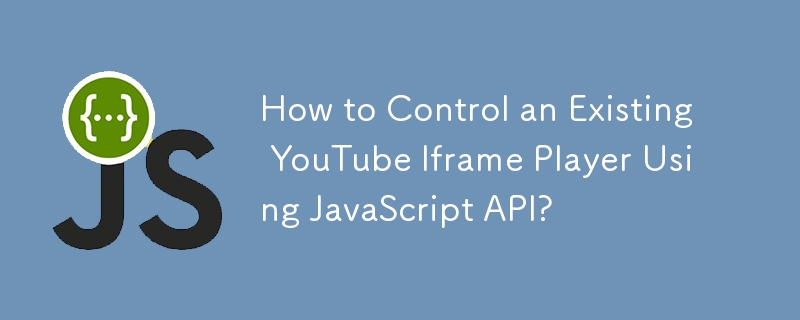

How to Control an Existing iframe YouTube Player with JavaScript API
The YouTube iframe API is commonly used to add and control YouTube videos on web pages. However, what if you want to control an iframe-based YouTube player that is already present in the HTML?
Traditionally, controlling such players was straightforward with the old embed method. However, this approach doesn't work with the newer iframe players. To address this, we're introducing a solution that allows you to assign an iframe player object and use the API functions on it.
Solution: callPlayer Function
The callPlayer function is a powerful tool that enables you to execute function calls on any framed YouTube video. This means you can access a comprehensive list of possible function calls, including playing, pausing, and seeking.
Implementation
function callPlayer(frame_id, func, args) {
// ... Function implementation
}To use the callPlayer function, simply provide the following parameters:
Example Usage
Here are some examples of how to use the callPlayer function:
callPlayer("my-video-iframe", "playVideo");callPlayer("my-video-iframe", "pauseVideo");callPlayer("my-video-iframe", "seekTo", [100, true]); // Seek to 100 seconds, allow seek aheadcallPlayer("my-video-iframe", "listening");Additional Notes
Conclusion
The callPlayer function is an invaluable tool that empowers you to seamlessly control existing iframe-based YouTube players with the JavaScript API. This powerful technique opens up a wide range of possibilities for web developers, enabling them to create interactive and immersive video experiences on their websites.
Das obige ist der detaillierte Inhalt vonWie steuere ich einen vorhandenen YouTube-Iframe-Player mithilfe der JavaScript-API?. Für weitere Informationen folgen Sie bitte anderen verwandten Artikeln auf der PHP chinesischen Website!
 Wie wäre es mit einem N5095-Prozessor?
Wie wäre es mit einem N5095-Prozessor?
 Wie viel ist Dimensity 8200 gleich Snapdragon?
Wie viel ist Dimensity 8200 gleich Snapdragon?
 Der Unterschied zwischen leichtgewichtigen Anwendungsservern und Cloud-Servern
Der Unterschied zwischen leichtgewichtigen Anwendungsservern und Cloud-Servern
 So lösen Sie err_connection_reset
So lösen Sie err_connection_reset
 js-Methode zum Löschen des Knotens
js-Methode zum Löschen des Knotens
 Welche Software ist Podcasting?
Welche Software ist Podcasting?
 Windows kann nicht auf den angegebenen Gerätepfad oder die angegebene Dateilösung zugreifen
Windows kann nicht auf den angegebenen Gerätepfad oder die angegebene Dateilösung zugreifen
 Linux fügt die Update-Quellenmethode hinzu
Linux fügt die Update-Quellenmethode hinzu




